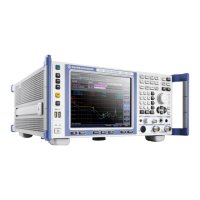Basic Measurement Examples
R&S
®
ESR
79Getting Started 1316.3749.02 ─ 09
7 Basic Measurement Examples
The following measurement examples are intended as an introduction to operat-
ing the R&S ESR. The User Manual contains additional and more advanced
examples. Refer to chapter "Advanced Measurement Examples" to find the fol-
lowing topics:
●
High-Sensitivity Harmonics Measurements
●
Separating Signals by Selecting an Appropriate Resolution Bandwidth
●
Intermodulation Measurements
●
Measuring Signals in the Vicinity of Noise
●
Measuring Noise Power Density
●
Measurement of Noise Power within a Transmission Channel
●
Measuring Phase Noise
●
Measuring Channel Power and Adjacent Channel Power
For a more detailed description of the basic operating steps, e.g. selecting menus
and setting parameters, refer to Chapter 6, "Basic Operations", on page 45.
7.1 Measuring a Sinusoidal Signal
One of the most common measurement tasks that can be handled by using a sig-
nal analyzer is determining the level and frequency of a signal. When measuring
an unknown signal, you can usually start with the presettings.
Test setup
1. NOTICE! Risk of instrument damage. Signal levels exceeding 30 dBm can
damage the RF attenuator or the input mixer. For the level calculation, take
the total power of all occuring signals into account.
If you measure signals higher than +30 dBm (= 1 W), insert a power attenua-
tor before the RF input of the analyzer.
2. Connect the RF output of the signal generator to the RF input of R&S ESR.
Measuring a Sinusoidal Signal

